Proceedings of the National seminar “Impact of Dr. B. R. Ambedkar’s Philosophy on Indian Literature” held at the Acharya Nagarjuna University on March 28th and 29th 2018 (3)
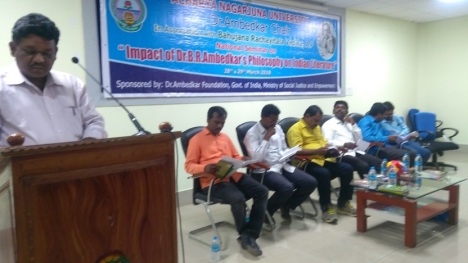
Vijayakumar presenting his paper
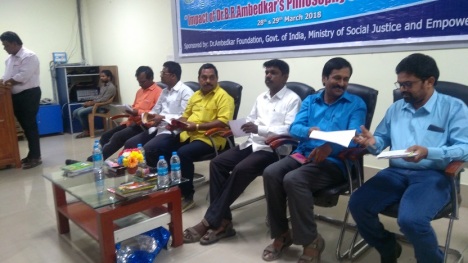
Koreswar moderating the session
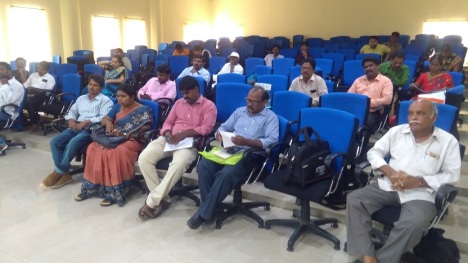
View of the audience listening to the presentation, session chaired by Koteswar

View of the audience listening to the presentation, session chaired by Koteswar
29-03-2018 – morning – paper reading session: The venue was shifted to LHS auditorium “Venugopal Reddy Auditorium.” The first session was chaired by Koteswara Rao with the following paper presentation:

11.00 am: First paper touched upon the impact of Ambedkar philosophy on the Marathi literature.
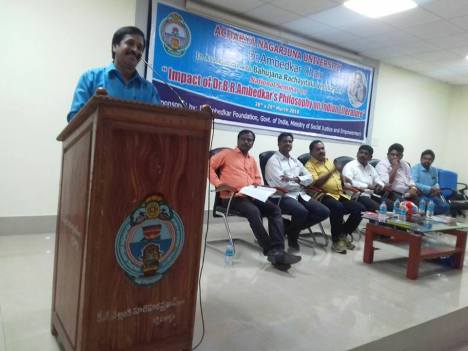
Bendalam Krishna Rao, journalist presenting his paper
11.14 am: Krishna Rao pointed out as to how the modern dalit Telugu poets have been inspired and influenced by the Ambedkar philosophy. He stressed under the guise of “dalit literature,” other castes need not be blasphemed or attacked excessively.
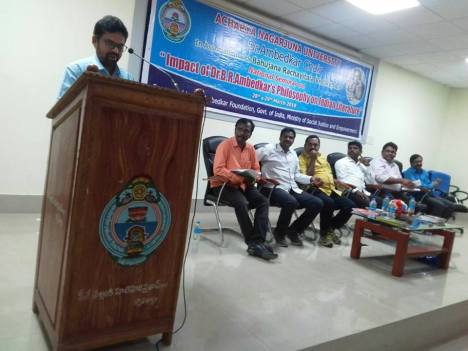
Kanchan Jeyaraj presenting paper, working with M-TV
11.28 am: Kanchana Jeyaraj, with M-TV pointed out that the media has been suppressing the facts of attacks on dalits. “Though, many cases were filed, only few punished; the fight was not only between the dalits and BCs, but also with MBCs, and others; Ambedkar accused media as “Congress papers,” as they did not publish what he said, but adding or removing certain words changing the context. Now also, same trend prevails and only M-TV broadcast atrocities committed against dalits. SC government officials, councillors, and others do not come to media and discuss about the atrocities committed against dalits, as they are controlled by the party-politics. Therefore, SCs should dominate media to create impact on the society.”
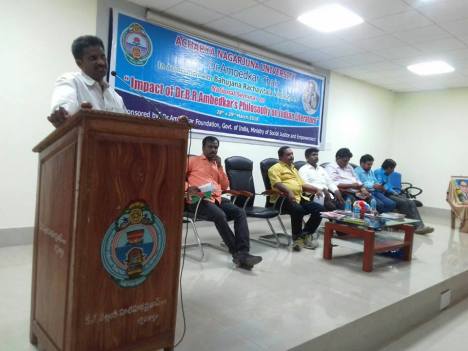
Dilip Matangi presentation
11.47 am: Matangi Dilipkumar explained about his magazine, “Bhimbum” and how the advertisements given to it, were stopped. As some body pointed out, he accepted that attacking “Brahmana and Brahmanavada” are different. If SC is raisen up, come up and occupying a big post, he does not want to fight like “street-fighters,” but, chosen to be within their rooms.
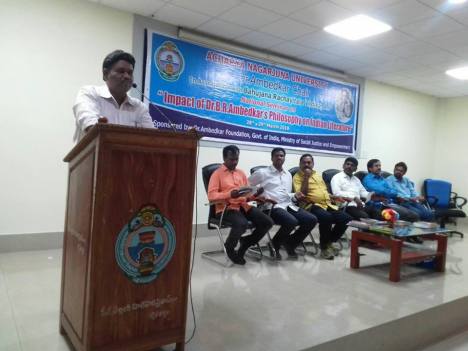
Ambedkar seminar, ANU, 2018- Vijayakumar presenting paper
12.34 pm: Vijayakumar, equated “Aryanism” with “Brahmanism” and continued his rhetoric. Only when Ambedkar brought out “Mukhnayak,” the Congress’ “National Herald” changed its attitude.

12.50 pm : Tangirala Soni sang a song.
12.54: Suresh Kumar[1] presented his paper, “Dalit literature: Movement in Andhra Pradesh,” repeating the points already made by other paper presenters. He pointed out as to how Basava, Annamacharya, Vemana, Veerabrahmam and others opposed caste system. He pointed out that non-dalit literature writers also contributed to dali literature.
1.03 pm: Ratna rendered a poem.
29-03-2018 – afternoon- paper reading session: The second session started with the paper presentation of the following:
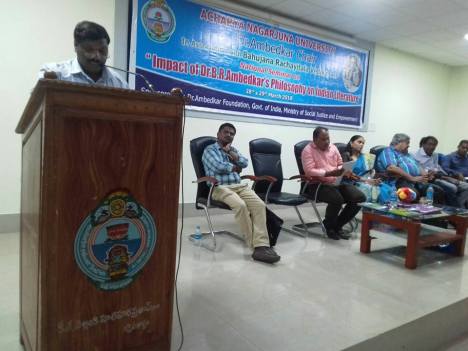
Ambedkar seminar, ANU, 2018- M. Srinivasa Rao presenting paper
1.10 pm: M. Srinivasa Rao[2] presented his paper, “Annihilation of caste system – Thoughts of Dr B. R. Ambedkar,” wherein, he brought out the points, “Caste dominates all in India…even Christians follow caste system..One poet asked, that they wanted a “OC-Christ”….A caste is a social group having two characteristics (a) membership is confined to those who are born of members and includes all persons so born and (b) the members are forbidden by an inexorable social law to marry outside the group..thus caste system is maintained…it has to be broken following the path pf Ambedkar.”
1.30 pm: Ramesh Babu argued that, “.there is no Indian literature to be called so…Charuvaka started questioning…..so also Buddha thereafter….in modern times, Ambedka questioned….as the culture of Aryans was animistic, that is not relating to India.”
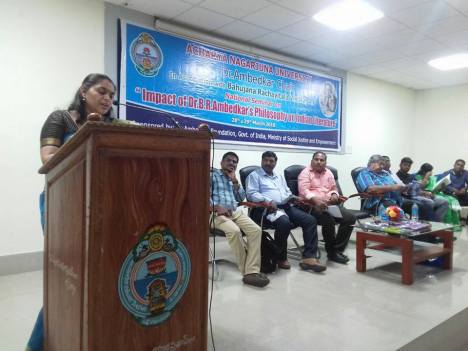
Ambedkar seminar, ANU, 2018-Anathalakshmi presenting paper
1.36 pm: Anathalakshmi[3] presented her paper on “Dr B. R. Ambedkar’s perspective of Indian women,” in which, she argued that “……Ambedkar deems that Buddha treated women with esteem and adoration and never attempted to humiliate them like Manu…on 25-12-1927, he burned a copy of “Manu Smriti”…He attended Women Conference on 18-07-1942……he incorporated provisions for women in the Indian Constitution including Uniform Civil Code under Article 44….Ambedkar brought out Acts for the benefit of women.In fact, Brahmin like Gajendra Gadekar supported Ambedkar, but, Nehru opposed and thus, the Hindu code Bill did not pass…. ”

Ambedkar seminar, ANU, 2018-K. V. Ramakrishna Rao presenting paper
1.50 pm: K. V. Ramakrishna Rao[4] presented his paper, “A comparative study of Socio-religious and Political philosophy of Dr B. R.Ambedkar and Periyar EVR,” contrasting the ideologies and philosophies of both under specific topics and issues – Education and background of the personalities; Marriage – marring a woman who was attending to them; Aryans, Dravidians and Race hypotheses and theories; Depressed Clases and Jews – how compared and treated by Ambedkar and Periyar; Brahmins and Jews – how compared and treated by Ambedkar and Periyar; Ambedkar, Periyar and Cripps (1940-42); How Gandhi was dealt with by Ambedkar and EVR; The question of Communism – how affected EVR and Ambedkar -Whether the three leaders were exploited by the Marxist ideology?[5]; after independence how they acted and reacted. For Ambedkar the 1940-1956 and EVR 1940-1973 periods were very crucial in assessing them[6]. From 1956 to 1992, the dravidian parties did not care Ambedkar, but, after 06-12-1992, they started exploiting him as a symbol. In fact, initially, Ambedkar’s statues were opposed in Tamilnasdu, as he was not a Tamilian and they were challenged with the Thevar statues. The literature produced by the Dravidian protagonists, Communist comrades and others exploited Ambedkar, but, maintained their ideology[7]. As there was no provision, he could not present PP with scanned documents brought.
29-03-2018 – after lunch- paper reading session: After lunch, the session continued with paper presentation.
2.50 pm: E. Harshavardhanan again continued with paper, repeating the same points yesterday presented.
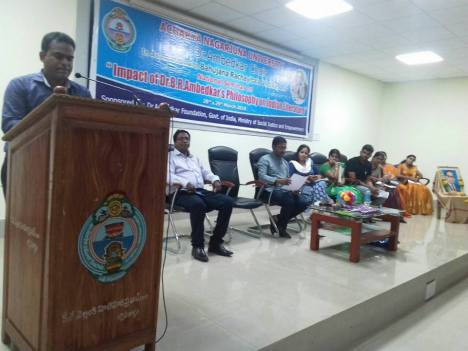
Ambedkar seminar, ANU, 2018- G. Satyanarayana, psychologist presenting paper
3.05 pm: G. Satyanarayana[8] presented his paper, “Personality of Dr B. R. Ambedkar: Pasychological Analysis” took his personality traits like conscientiousness, extroversion, openness and self-actualization and concluded that no “neuroticism” features are found in such analysis. Being a psychology expert, initially, he was so emotional and controlled himself and then, started his presentation.
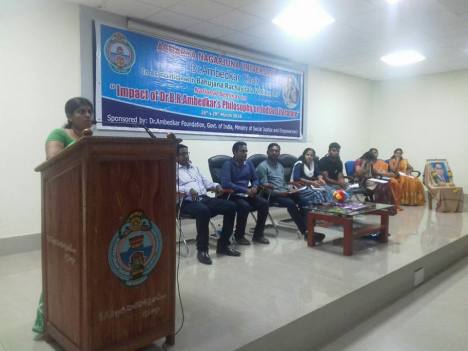
Ambedkar seminar, ANU, 2018- Santakumari presenting paper
3.19 pm: Shantakumari presented her paper based on a drama written by Vijaya Bhaskara “Kurchi” (Chair) and compared with reservation made to SCs.
3.31 pm: Amruta Rao presented a paper about the impact of Ambedkar philosophy on Telugu literature. The same points already made were repeated.

Ambedkar seminar, ANU, 2018- Aruna Gogulamanda presentation
3.41 pm: Aruna Gogulamanda delved upon the Ambedkar philosophy on the dalit literature.
3.55 pm:
4.20 pm: Urmila and Sarita
4.27 pm: Sarita presented a paper comparing untouchability issue as depicted in the story of Munshi Premchand with that of Ambedkar philosophy.
4.30 pm: Nagamani presented a paper on caste system.
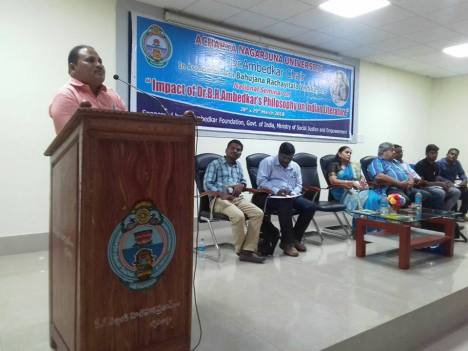
Valedictory function: Valedictory function had been formal and the participants were asked to express their views. N. Ravikumar pointed out that those who have not read Ambedkar books or understood him presented papers. His BRV has been working for the last three years for the welfare of the Ambedkarites fighting for their rights. The dilution of the SC-At Act by the Supreme Court recently has to be discussed seriously. One should write about their mother, then, only, the Ambedkarite consciousness could be nurtured and developed. The views expressed by the participants:
- The Ambedkar philosophy should be brought out in the “artform” [street play, burra katha etc] to reach people.
- Reserved seats for SCs – SCs should be careful to vote, as some SC-leaders become political agents / “yes-servants” thus defeating the very purpose of “reserved constituencies.”
- BSP party leaders asserted that BSP experiment is enough and no other /new experiment is required.
- The Communist exploitation of Ambedkar, Ambedkarites and Dalits should be checked and controlled.
- The Communists do not have the photo of Ambedkar in their party officers, as they cannot place anybody at par with Marx, Lenin, Mao etc., therefore, exploiting Ambedkar and getting funds by them should be stopped.
© K. V. Ramakrishna Rao
31-03-2018
[1] See Abstarcts, p.17.
[2] See Abstarcts, p.35-36.
[3] See Abstarcts, p.34-35.
[4] See Abstarcts, p.28-29.
[5] K. V. Ramakrishna Rao, The Impact of Communism on the Dravidian Movement 1930-40, proceedings of the South Indian Congress 13th session held at Government Arts College, Coimbatore, January 9th to 11th, 1993, pp.200-205.
Rao, K.V. Ramakrishna. “The Impact of Communism on the Dravidian Movement, 1930-40.” In Ethnic Movement in Transition: Ideology and Culture in a Changing Society, Kanishk Publishers, New Delhi, (1998): 87.
- V. Ramakrishna Rao, The Impact of Communism on Dravidian Movement 1940-50, a paper presented at the 15th session of THHC held at Periyar Maniammai University, Vallam, September 19th-21st, 2008 and published in the PTNHC, pp.150-154.
[6] K. V. Ramakrishna Rao, The Historic Meeting of Ambedkar, Jinnah and Periyar, Proceedings of 21st session of South Indian History Congress, Madurai Kamaraj University, Madurai, 2001, , pp.128-136.
[7] The literature produced by Periyar, Anna, Karunanidi had been divisive and anti-national; M. P. Sivagnanam has been of nationalistic; B. Ramamurthy nationalistic and communist; DK-radical Dravidian groups Marxist, Maoist and anti-national; Ayothithas Pandithar, Erattaimalai Srinivasan ettc., Buddhist, Ambedkarite and nationalist.
[8] See Abstarcts, p.11-12.
Filed under: ambedkar, andhra, anti-india, anti-indian, dalit, Dravida, Dravidam, dravidar, Dravidian, emotion, gandhi, gandhiji, historicity, historiography, history, language, linguistics, myth, mythology, oppressed, politics, rama, Ramakrishna Rao, Rigveda, sankara, Sanskrit, sanskrit, telengana, telugu, tirumalai, tradition, tribal, tribe, Vayu, Veda, Vedas, vyasa, woman, women, young, youth | Tagged: ambedkar, ambedkar chair, ambedkar philosophy, ambedkarism, ambedkarite, B.R.Ambedkar, dalit, dalit Buddhist, dalit christian, dalit hindu, dalit Jain, dalit literature, dalit muslim, dalit politics, dalitastan, ideology, marxist philosophy, philosophy, technology | Leave a comment »

















